
Number 1 Squadron, also known as No. 1 (Fighter) Squadron, is a squadron of the Royal Air Force. It was the first squadron to fly a VTOL aircraft. It currently operates Eurofighter Typhoon aircraft from RAF Lossiemouth.
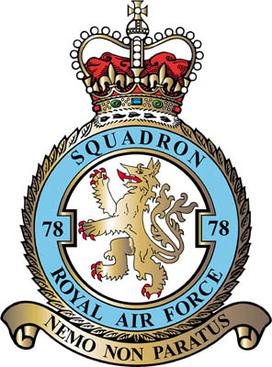
No. 78 Squadron of the Royal Air Force, is the squadron number plate of RAF (Unit) Swanwick based at London Area Control Centre, Swanwick, Hampshire. The squadron was allocated the role in early 2021.
No. 75 Squadron was a unit of the Royal Flying Corps and Royal Air Force in World War I and the RAF in World War II. In 1940–1945, it was a bomber unit composed mainly of New Zealand-born personnel. In October 1945, the squadron number – along with its heraldry and honours – was relinquished by the RAF and transferred to the Royal New Zealand Air Force, officially becoming No. 75 Squadron RNZAF. No other RAF squadron has been gifted in this way, to another Commonwealth air force.

The Martin 187 Baltimore was a twin-engined light attack bomber built by the Glenn L. Martin Company in the United States as the A-30. The model was originally ordered by the French in May 1940 as a follow-up to the earlier Martin Maryland, then in service in France. With the fall of France, the production series was diverted to Great Britain and after mid-1941, supplied by the U.S. as Lend Lease equipment.

The Vultee A-31 Vengeance is an American dive bomber of World War II that was built by Vultee Aircraft. A modified version was designated A-35. The Vengeance was not used operationally by the United States, but was operated as a front-line aircraft by the British Royal Air Force, the Royal Australian Air Force, and the Indian Air Force in Southeast Asia and the Southwest Pacific. The A-31 remained in service with U.S. units until 1945, primarily in a target-tug role.
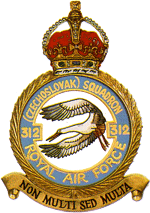
No. 312 Squadron RAF was a Czechoslovak-manned fighter squadron of the Royal Air Force in the Second World War.

No. 453 Squadron is an air traffic control unit of the Royal Australian Air Force. It was established at Bankstown, New South Wales, in 1941 as a fighter squadron, in accordance with Article XV of the Empire Air Training Scheme for overseas service with the Royal Air Force during World War II. No. 453 Squadron saw combat first in the Malayan and Singapore campaigns of 1941–42. Severe aircraft losses effectively destroyed the squadron and it was disbanded in March 1942. A successor unit by the same name was raised in Britain from mid-1942, to take part in fighting against Nazi Germany in Europe until 1945. The squadron was disbanded in 1946. It was re-formed in its current role in 2011.
The No. 341 Squadron also known in French as Groupe de Chasse n° 3/2 "Alsace", was a Free French squadron in the RAF during World War II.

No. 609 Squadron of the Royal Auxiliary Air Force, originally formed as a bomber squadron and in the Second World War active as fighter squadron, nowadays provides personnel to augment and support the operations of the Royal Air Force. The squadron is no longer a flying squadron, but instead has the role of Force Protection. It is currently based at RAF Leeming, North Yorkshire.

Royal Air Force Andrews Field or more simply RAF Andrews Field is a former Royal Air Force station located 4 miles (6.4 km) east-northeast of Great Dunmow Essex, England.
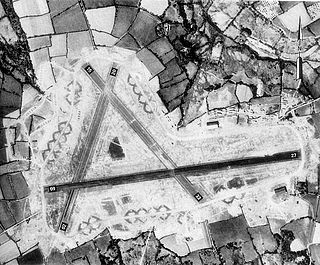
RAF Upottery is a former Royal Air Force station in East Devon, England. The airfield is located near the village of Upottery, approximately 6 miles (9.7 km) north-northeast of the town of Honiton.
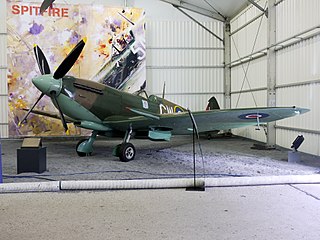
No. 340 Squadron RAF was formed at RAF Turnhouse in Scotland on 7 November 1941 as part of Le Groupe de Chasse IV/2 "Île-de-France". The squadron was first equipped with Supermarine Spitfire Mk I fighters and consisted of two flights - A Flight ("Paris") and B Flight ("Versailles").
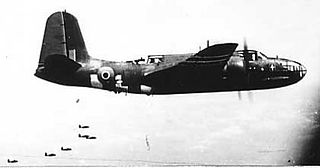
The No. 342 Squadron also known in French as ''Groupe de Bombardement n° 1/20 "Lorraine", was a Free French squadron in the RAF during World War II.

Ján Ambruš, OBE was a Slovak aerobatics and fighter pilot. He flew with the French Air Force in the Battle of France and the Royal Air Force in the Battle of Britain. After the Communist takeover of Czechoslovakia he escaped and settled in the US, where he worked as a design engineer.
No. 343 Squadron was a Free French anti-submarine patrol squadron given a Royal Air Force squadron number during World War II.
No. 344 Squadron was a Free French land based anti-submarine squadron given a Royal Air Force squadron number during World War II.
No. 326 Squadron RAF was a Free French fighter squadron given a Royal Air Force squadron number during World War II.
The No. 345 Squadron RAF was a Free French ground attack fighter squadron given a Royal Air Force squadron number during World War II.
The No. 347 Squadron RAF was a French bomber squadron given a Royal Air Force squadron number during World War II.












